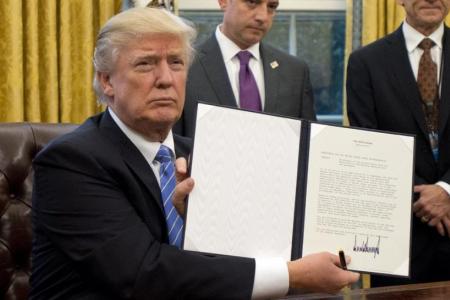TPP in a nutshell
US President Donald Trump on Monday made good his promise of pulling out of the Trans-Pacific Partnership (TPP) free trade pact by signing an executive order for the US to formally withdraw from the 12-nation agreement.
WHAT IS THE TPP?
It is one of the most ambitious free trade agreements ever attempted and involved 12 countries - the US, Australia, Brunei, Canada, Chile, Japan, Malaysia, Mexico, New Zealand, Peru, Singapore and Vietnam.
It is aimed at deepening economic ties among these nations and is expected to reduce tariffs - even eliminate them in some cases - and help open up trade in goods and services.
It is also expected to boost investment flows between the countries and further boost their economic growth.
For the US, the TPP represents 40 per cent of world trade and a destination for over 60 per cent of US exports.
Initial estimates claim the TPP would add US$305 billion (S$430 billion) in exports a year globally, with nearly half accounted for by an increase in US exports by an additional US$123.5 billion.
WHAT THE US PRESIDENT SAYS ABOUT IT
Mr Trump, who said in his inauguration speech on Jan 20 that it would be "America first" on all issues from now on, has long opposed the TPP and other free trade deals, saying they take jobs away from Americans.
He said he would protect US workers against competition from low-wage countries like Vietnam and Malaysia, parties to the TPP deal.
Mr Trump intends to "negotiate fair bilateral trade deals that bring jobs and industry back" and allow the US to quickly terminate the deals in 30 days "if somebody misbehaves".
His stance mirrors a growing feeling among Americans that international trade deals have hurt the US job market. Fellow Republicans have long held the view that free trade is a must, but that has been changing.
WHAT TPP EXIT MEANS FOR AMERICA
US businesses will lose access to potential markets. Carmakers had hoped to see tariffs slashed in Asia and farmers wanted the removal of trade taxes that prevent them from selling goods, particularly poultry, overseas.
Tech companies such as Google and mobile phone providers had sought to lessen regulations and gain entry into some countries involved in the deal.
Analysts say many of the manufacturing and low-skill jobs lost to other countries will not return to the US due to factors such as rising wages and new technology, contrary to what Mr Trump thinks.
WHAT IT MEANS FOR CHINA
The US withdrawal creates a political and economic vacuum that China is eager to fill. Chinese Communist leaders are ramping up their globalisation efforts and championing the virtues of free trade.
In an address to the World Economic Forum (WEF) on Jan 17, Chinese President Xi Jinping likened protectionism to "locking oneself in a dark room" and signaled China would look to negotiate regional trade deals.
China is advocating for a 16-nation pact called the Regional Comprehensive Economic Partnership (RCEP) that excludes the US and lacks some of the environmental and labour protections Mr Obama negotiated into the TPP.
The RECP would include South-east Asia countries, as well as Japan, South Korea, Australia, New Zealand and India.
WHAT IT MEANS FOR ASIAN TPP MEMBERS
The development is seen as a blow to Japan, which has spent considerable political capital championing the pact.
It was the last nation to join the pact, which would give its manufacturers tariff-free access to export markets in the US and other Asian countries, but would bring its automakers into competition with lower-wage countries like Mexico.
Japanese Prime Minister Shinzo Abe became a strong enthusiast after making politically painful concessions on agricultural imports that the US had sought.
The withdrawal of the US also represents a loss of opportunities for Vietnam, Malaysia, Brunei and, to a smaller extent, Singapore.
WHAT IT MEANS FOR US
Analysts say Singapore can still rely on the numerous FTAs it has with most TPP members and Asean to soften the blow from a potential delay in the implementation of a Trump-shaped TPP.
They believe the economic impact on Singapore would be limited as it already has an open economy and extensive bilateral agreements in place - including an existing FTA with the US.
WHAT COULD HAPPEN NEXT
The US could renegotiate the pact or Asia could proceed with an alternative trade deal backed by China.
The US is unlikely to walk away from a trade pact that accounts for more than 40 per cent of the world's gross domestic product and leave the door open for the China-backed RCEP.
"Much of China's economic diplomacy is beneficial.
"But the hidden cost is, at this stage, China is not committed to the open trading system the US had sought to build, and will not likely promote open trade in services or reduction of non-tariff barriers such as subsidies," said Mr Philip Jeyaretnam, senior counsel and regional chief executive at Singapore-based Dentons Rodyk.
In short, a regional trade pact that does not involve the US is not desirable.
This has been updated from a previous article.
Sources: The Straits Times Archives, AFP, Reuters, Washington Post, Bloomberg
Get The New Paper on your phone with the free TNP app. Download from the Apple App Store or Google Play Store now



